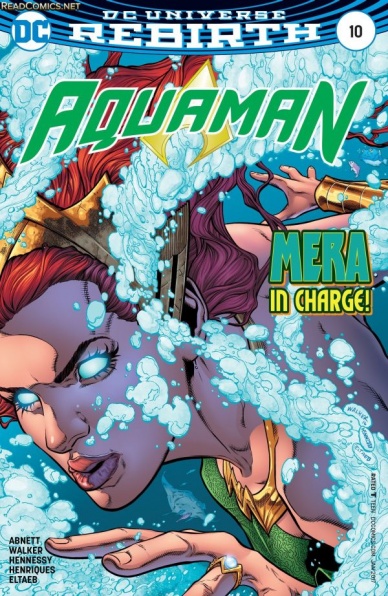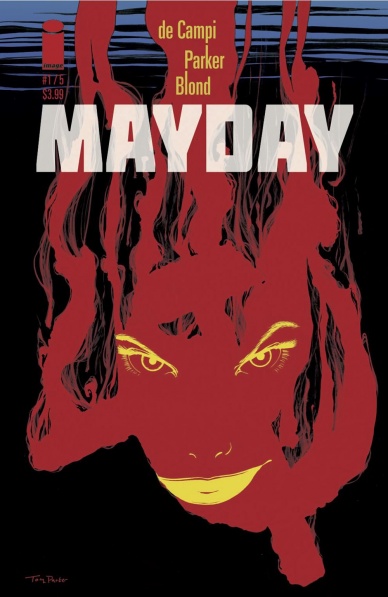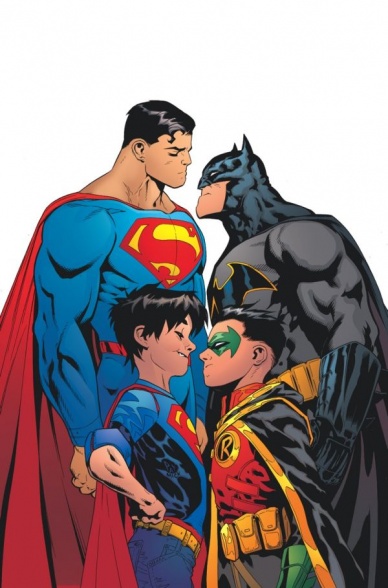There is a lot to cover on Wednesdays. We should know, as collectively, we read an insane amount of comics. Even with a large review staff, it’s hard to get to everything. With that in mind, we’re back with Wrapping Wednesday, where we look at some of the books we missed in what was another great week of comics.
Let’s get this party started.

Aquaman #10
Written by Dan Abnett
Illustrated by Brad Walker
Reviewed by Robbie Pleasant
While Aquaman has been out fighting and dealing with the daily struggles of being a king, Mera’s been off on her own sub-plot about undergoing some trials to prove she’s worthy to be the queen. This issue turns the focus to Mera, and her trial going about as badly as one would expect.
Fortunately, Mera is a great character; she’s strong, determined, and typically has more to her character than just her relationship with Aquaman. (Admittedly, a portion of the issue does involve her worrying about the future of her relationship with him, but all things considered, it’s a natural moment for it to occur. And even with that scene, the issue still passes the Bechdel Test several times over.) So putting some focus on her while building the suspense about Aquaman’s fate works very well, and sets the scene for a number of possible events, any of which would make for a good story.
Of course, Brad Walker’s artwork helps as well. The characters are very expressive, adding a proper level of emotion to each line and moment. Drawing underwater scenes can often be hit-or-miss, but he hits them each time, with just the right amount of bubbles accompanying action, and characters posed in natural floating positions.
The most interesting part, though, is the fun with prophecies. It’s set up nicely, both in dialogue and art. The prophecy is displayed through floating bubbles, before they turn red and burst over a scene of crimson, with shadowed figures and a twisted landscape. But Dan Abnett has planned out exactly what each line of the prophecy means, and seeing each part make sense after it’s come to pass carries the story quite well.
Final Verdict: 7.8 – A strong Mera-centric issue, giving her a chance to shine and struggles to overcome, accompanied with solid artwork and good pacing.

Faith #5
Written by Jody Houser, Louise Simonson & Rafer Roberts
Illustrated by Meghan Hetrick, Marguerite Sauvage, Pere Perez & Colleen Doran
Review by Ken Godberson III
Right. Three stories in this oversized issue, so let’s just break ‘em down.
Dark Star: Part One by Houser, Hetrick & Sauvage
Start of a new story that sees the return of Project Rising Spirit, but is more about societal pressures on celebrities, in particular female celebrities. It does this through celebrity and latent psiot, Zoe. It is an interesting look at this pressure and you really do feel for this kid. There was one small I winced at though. This story has the same theme as “The Wicked + The Divine #13”, the “Fucking Tara” issue. And I know this because Faith even says “If WicDiv #13 was required reading before posting on the internet, I bet the world would be a better place.” While true, and that I guess is something Faith would say, it’s kind of in that “Please don’t remind me of other books I could be reading” area. Meghan Hetrick takes on art duties with this issue and she has a much more flowing art style than previous artist Pere Perez. That flow helps a great deal when displaying Zoe’s abilities, making for some creepy effects.
Faith In Politics by Simonson & Perez
And we come to the story that this issue was so touted and discussed about: Where Faith Herber meets Hillary Clinton. Guess I should get this one out of the way: I am a leftist. I am voting for Hillary. And I personally think that those who felt Valiant should treat the candidates as equals seem to not understand the meaning of “equal” when the other one is being endorsed by literal Klansmen and literal Nazis. And yeah, this story does support Hillary, but it’s not exactly about that. It’s actually more about voter apathy and how it’s a really bad thing and it’s easy to get discouraged about the process, as showed by the villain Faith takes on. The story can border on hokey at times, but it’s a serviceable message. And unlike Marvel, this actually came out before the election!
Continued belowNo Days Off by Roberts & Doran
A very simple story involving Faith on a long shift of superhero duty. That in spite of how tired she is, it’s all worth it for the people she can save. It’s not groundbreaking, but Colleen Doran and colorist David Baron provide a nice, clean art style to compliment the story.
Final Verdict: 6.3- Solid enough compilation of stories on the eve of a very important day.

Flash Gordon: Kings Cross #1
Written by Jeff Parker
Illustrated by Jesse Hamm and Grace Allison
Reviewed by Matthew Garcia
Part of the joy of Dynamite’s “Flash Gordon” series is it’s so consistently goofy and over-the-top. It’s entertaining as balls to read. Despite its general adherence to convention and archetype, despite how everything plays out like your standard crossover event, Jeff Parker and Jesse Hamm have managed to deliver a book that’s a lot of fun and just nice to have around. It bristles with a Silver Age-like energy, one so that even if we know that none of the events in “Flash Gordon: King’s Cross” #1 are necessarily original, the comic thinks they are. It’s charming.
“Flash Gordon: King’s Cross” #1 finds our heroes (The Phantom(s), Mandrake the Magician, etc.) spread out all over the universe after defeating an invasion from Emperor Ming. They’ve settled into their crime-fighting or science experiments or whatever it is they do. For the most part, it involves them confronting the people who originally helped Ming. Meanwhile, all these earthquakes are occurring across the world, stirring up freak tidal waves and other such mayhem. Through a series of convoluted events, Flash are the crew are reunited and off to investigate.
I think one of the problems I’ve encountered with Jeff Parker’s scripting — and it’s most definitely evident here — is his inability to slow down and to contemplate. “Flash Gordon: King’s Cross” #1 is packed with action and pandemonium. The set pieces are well done and well delivered, with Hamm gleefully presenting these characters in motion. But without giving Flash and the crew a moment to slow down and linger on something (or trying to let it pass by giving Hamm a wide establishing shot while the characters still speak hurriedly), we’re not given that moment either. The whole story goes by in a blur. It’s so desperate to appease you, you kind of forget about it by the time you’ve finished reading.
“Flash Gordon: King’s Cross” #1 will probably have some crazy cliffhangers and fun adventuring. It’s been a consistent feature of the series. The art will be bright and lively and it will probably give the story a slight bounce. Ultimately, however, if Dynamite didn’t keep relaunching these events, it would be easy to forget they even existed.
Final Verdict: 6.5 – A Silver Age energy makes the experience fun and engaging, even if you’ll remember nothing about it 10 minutes later.

“Mayday” #1
Written by Alex de Campi
Illustrated by Tony Parker
Reviewed by Stephenson Ardern-Sodje
Mad Men meets John Le Carre as de Campi and Parker bring the heat to the Cold War.
The shifting allegiances and shady dealings of 70’s pseudo-political agencies make for great inspiration. de Campi’s love of the weird and wonderful world of C.I.A/FBI/Russian Intelligence shines through in “Mayday” #1 as she stitches together two parallel tales; one of the stiff shirts who seek to outdo one another in boardroom espionage, and one of the field agents who have to act out those decisions in the real world. This first issue feels packed with uncertainty. The characters are set up and let loose without a backward glance, and the action gallops forward. There are moments where this stripped back style leaves the book feeling a little confusing, but it’s almost certainly de Campi’s intention, and there’s a meticulousness to her curation of the narrative, from the characters to the recommended soundtrack, that suggests she’s got it all planned out for down the road.
And it wouldn’t be the 70’s without copious helpings of mind-expanding psychedelics to smooth the transition. Parker’s detailed, delicately lined artwork kicks off the issue well, with echoes of Ramon Villalobos or Chris Burnham, but the crux of the issue is a fantastic and fantasy-filled spread of LSD-induced dreaminess that sees characters shifting and morphing like paisley-patterned nightmares. Colorist Blond trips out accordingly with a palette of hues that perfectly encapsulate an inspiring and terrifying emotional state, slipping almost imperceptibly from the world of the real to the land of imagination. The same disconcerting uncertainty that permeates the script is definitely present in the art in a way that feels at times exciting, and at times slightly unsettling.
Continued belowFinal Verdict: – 6.6. Beautiful and barmy, this book is a pretty full-on leap into a very strange section of recent history.

Shade: The Changing Girl #2
Written by Cecil Castellucci
Illustrated by Marley Zarcone
Reviewed by Liam Budd
“Shade: The Changing Girl” continues into its second issue to be just as charming as it is peculiar. Here we find Megan, taken over by an alien from outer space and the madness vest, return back to school after waking up from her coma. The plot of this issue allows writer Cecil Castellucci to play around with a lot of the many high school drama stories we’ve seen before across pop culture. Imagine “Archie” crossed with “Transmetropolitan” or if “Clueless” was set in the world of “Twin Peaks.” Though the weirdness never feels arbitrary or forced, in fact there are times when you begin to understand the method to the madness.
Castellucci has built her script like a puzzle for the readers to work out, but she has made sure to give us all the necessary tools to do so. There is no need to explicitly go into Megan’s backstory for example when we can use the narration to work out for ourselves that she used to be the archetypal ‘Queen Bee’ of her school until she fell into her coma. You may have to put a little bit more work into reading “Shade” to understand what is going on, but when the intricacies become clear, and you come to understand her method, a wonderful clockwork like story becomes clear. The entire experience is wholly original, creative and just plain fun.
Yet a great deal of the charm comes down to Marley Zarcone’s beautiful and dreamlike artwork. Zarcone’s style is smooth and soft and completely encapsulates the new world that Megan and Shade are living in. It is childish and zany yet utterly terrifying, Zarcone’s art reflects the theme of being trapped in madness brilliantly well. Similarly, just like Castellucci’s writing, he is very precise when it comes to creating the weird and bizarre, there is a clear amount of thought that goes into the scenes he conjures up. The writing and the art shows a good deal of collaboration between the creative team and it certainly pays off.
Final Verdict: 7.9 – A weird and wonderful clockwork puzzle.

Superman #10
Written by Peter Tomasi and Patrick Gleason
Illustrated by Patrick Gleason
Reviewed by Brian Salvatore
Peter Tomasi and Patrick Gleason made one of the most quietly successful series of the New 52, “Batman and Robin.” It was rarely the comic where huge comic news broke, but it was such a study in characterization and growth and, aside from Grant Morrison, no creators have had done more with Bruce and Damian than Tomasi and Gleason. With them moving over to the Kent family’s father/son dynamic, it seemed like only a matter of time before the two pairs of fathers and sons met.
The first thing that strikes you about this issue is the stark difference between the families, but none of that is news. Obviously, the Kents are more trusting than the Waynes; the Waynes are far more prepared and suspicious than the Kents. And yes, Damian is walking a fine line of what a ‘hero’ should do – you know, spying on and kidnapping Jon – but he’s always presented as someone who is trying to do ‘the right thing,’ even if that right thing is flawed and misguided.
But even if Tomasi’s script was clunky or dispassionate – and it’s not – Gleason’s art would sell me on this issue 100 times out of 100. He has such a grasp on these characters that the smallest facial expression can tell the story far better than a paragraph of dialogue could. His Bruce and Clark are not necessarily comfortable in the same room, and their posture tells you that. His Jon relaxes when his dad shows up, his Damian tenses when his does. Everything about the visual storytelling is absolutely spot on, and elevates this book to something special.
This issue is a backdoor pilot for “Super Son,” the new Tomasi/Jorge Jimenez series dropping in February, and in just one issue, the case is made that these characters not only deserve, but with thrive, in their own series.
Continued belowFinal Verdict: 8.5 – Is it February yet?

The Unworthy Thor #1
Written by Jason Aaron
Illustrated by Olivier Coipel
Reviewed by Alice W. Castle
Thor is a strange character, when you think of it. Not in terms of the fact that he is literally the Norse God of Thunder and a part-time superhero, but in terms of his thematic arc. His origin story is all about humbling his youthful arrogance and ever since then, he’s been this very stoic, unmoving character. The world changes around him, but the Odinson stays true.
Jason Aaron has been all about turning that notion on its head since he began writing the character in “Thor: God Of Thunder”. From showing the perspectives of three distinct times in Thor’s life to revealing his unworthiness to someone else taking up the mantle, things have been tumultuous in the Odinson’s life.
This first issue of the Odinson’s quest to reclaim Mjolnir shows him at his most downbeat and haggard and it was a perfect move to bring back Olivier Coipel. Coipel redefined Thor in the mid-2000s alongside J. Michael Straczynski . Seeing his much more gritty and grimey art depicting the Odinson as compared to the relatively cleaner and more vibrant work by Russell Dauterman on “Mighty Thor”.
Coipel fills this issue with amazing action on an awesome scale while also allowing Odinson’s queit brooding space to breathe in storytelling mastery. Having Matthew Wilson on board keeps a similar palette to “Mighty Thor”, just muted and desaturated to match the depression hanging over the Odinson.
Final Verdict: 9.0 – Jason Aaron starts a new chapter in his Thor chronicles by bringing back living legend Olivier Coipel for an engaging first issue.






